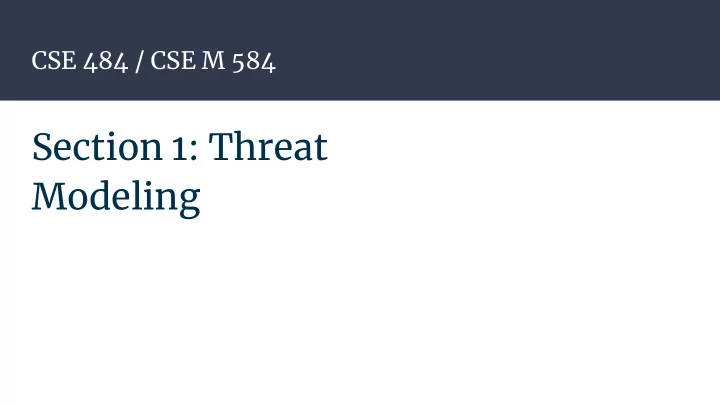

CSE 484 / CSE M 584 Section 1: Threat Modeling
TA Introduction Keanu Vestil, he/him (keanu@cs.washington.edu) Eric Zeng, he/him (ericzeng@cs.washington.edu) Office Hours TBD - stay tuned!
Icebreaker In breakout rooms, share your answers to the following questions: - What is your name? - Why are you taking this class? - Have you had any experiences with computer security and privacy in your personal life?
Administrativa What’s assigned? Ethics form - Due October 7 ● In-class activities (canvas “quizzes” during breakouts) ● 3 Homeworks (HW1 due October 9) ● 3 Labs ● Final project ● 584 students: research papers (1st due next Oct 8th) ●
Student Resource List (See course website, under sections)
What is threat modelling? An approach for analyzing the security of a computer system ● Examine the potential vulnerabilities and risks of the system, ● and how attackers might approach it What are we protecting? ○ What does an attacker have to gain? ○ How would an attacker try to exploit the system? ○
Threat Model Assets ➔ What are we trying to protect? How valuable are those assets? Adversaries ➔ Who might try to attack, and why? Vulnerabilities ➔ How might the system be weak? Threats ➔ What actions might an adversary take to exploit vulnerabilities? Risk ➔ How important are assets? How likely is an exploit? Possible Defenses ➔
What does it mean to be “secure”? The traditional goals of security are: Confidentiality ● Integrity ● Authentication ● Availability ●
Confidentiality Confidentiality is the concealment of information Eavesdropping, packet sniffing, illegal copying network
Integrity Integrity is the prevention of unauthorized changes Intercept messages, tamper, and release again network
Authenticity Authenticity is knowing who you’re talking to Unauthorized assumption of other’s identity network
Availability Availability is the ability to use information or resources Overwhelm or crash servers, disrupt infrastructure network
Threat Modeling Examples: Social Media Services Tip Be aware what information you are giving away Be aware how they are being used
Assets What are we trying to protect? User Data ● Personal Info (Date of birth, SSN, phone #) ○ User generated content (messages, photos, posts) ○ Ad targeting information ○ How valuable are those assets? Potentially very personal ● Cannot be measured by money ●
Adversaries Who might try to attack, and why? Foreign governments ● Other companies ● Tip Some adversaries Hackers ● might not be obvious. Users misuse can also Employees ● cause unintentional problems. Other users ●
Vulnerabilities & Threats How might the system be weak? How might an adversary exploit vulnerabilities? Code vulnerabilities ● Weak passwords ● Social engineering ● Insider threats (employees) ● Physical threats ●
Risks How important are assets? Legal and ethical aspects ● Legal ramifications ○ Company reputation ○ Personal information of customers ○ How likely is a successful attack? How many resources would the adversary need to ● execute an attack? Can deter, but attackers have asymmetric advantage ●
Asymmetric Advantage An attacker only needs to win in one place.
Defense-in-depth Write code using secure tools and practices ● Store only the information you need to store ● Limit employee access to user data ● Enforce strong password rules for users ●
Section Activity: Adversarial thinking about design assumptions https://canvas.uw.edu/courses/1396608/quizzes/1320385
Some examples of systems…. Echo Dot Grocery store Self-driving cars self checkout Quotes for illustration purposes only https://canvas.uw.edu/courses/1396608/quizzes/1320385
Section Student Please fill out this quick Survey survey on Canvas to help us help you learn! Name https://canvas.uw.edu/courses ● /1396608/quizzes/1320551 ● Preferred Pronouns ● What helps you participate in class? Is there anything I should know ● to help you learn?
Reminders! - Find people to work with! [Up to 3 people per group] - Fill out the ethics form [Due next Wednesday 11:59 pm] - Check discussion board regularly!
Recommend
More recommend